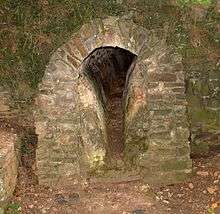Calcareous sinter
Calcareous sinter is a freshwater calcium carbonate deposit, also known as calc-sinter. Deposits are characterised by low porosity and well-developed lamination. Calcareous sinter should not be confused with siliceous sinter, which the term sinter more frequently refers to. It has been suggested that the term "sinter" should be restricted to siliceous spring deposits and be dropped for calcareous deposits entirely.
Features
Calcareous sinter is characterised by laminations of prismatic crystals growing perpendicular to the substrate; laminations are separated by thin layers of microcrystalline carbonate.[1] Macrophytes are absent, consequently porosity is very low. Exclusion of species is due either to high temperature (travertine), high pH/ion content (tufa) or absence of light (speleothems).
Pedley (1990)[2] suggests the term be abandoned in favour of tufa for ambient temperature deposits (and presumably travertine for geothermally heated deposits). This avoids any potential confusion with siliceous sinter and prevents deposits formed in different environmental conditions (hot spring deposits, cold spring deposits and speleothems are all lumped together under the term sinter) from being amalgamated into one group.
Geochemistry
Deposits are formed from either calcite or aragonite. Precipitation is brought about by degassing of CO2, which decreases the solubility of calcite/aragonite. (See tufa/geochemistry)
Notable deposits
-
Pure calc sinter, typical for aqueducts and all kinds of water facilities.
-

Roman aqueduct in Germania Inferior. Eifel Aqueduct, clogged by fine sinter.
-

Deposits of several thousand years of calc sinter (travertine) in the Bridgeport, California Hot Springs
References
- ↑ Flügel, E. 2004. Microfacies of Carbonate Rocks. Germany: Spring-Verlag. ISBN 3-540-22016-X
- ↑ Pedley, H.M. 1990. Classification and environmental models of cool freshwater tufas. Sedimentary Geology 68, pp. 143-154.